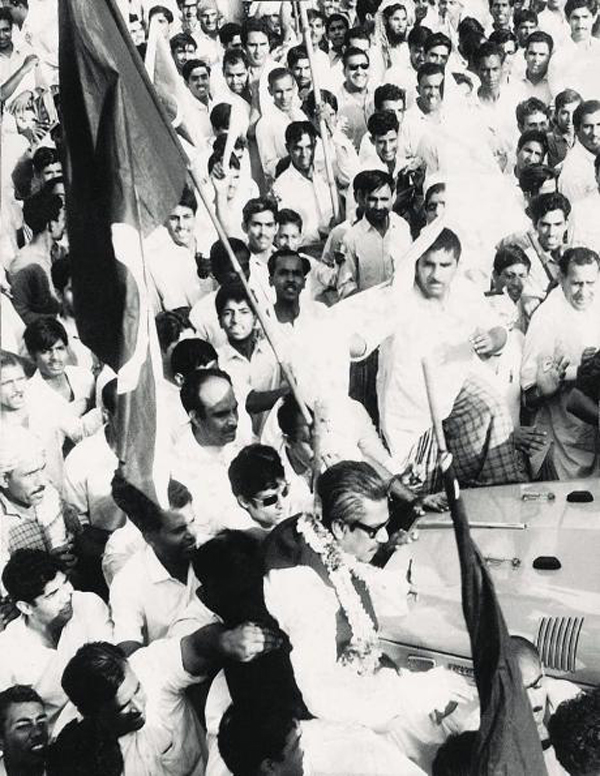Time Period:
October 1968 to 25 March 1969
Goals:
To pressure president and military dictator Ayub Khan out of office.
During the fall of 1968, Ayub Khan celebrated his tenth year as president of Pakistan. In honor of this anniversary, he declared his reign as the “Decade of Development,” an action that sparked an outbreak of protests against the state.
Much of Pakistan was already discontent with the Ayub regime. Following the 1965 war with India, Pakistan experienced a huge economic gap. The working classes faced the burden of this disparity.
Pakistan’s second president and its first military dictator, Ayub Khan saw to huge economic growth. However, in embracing private-sector industrialization and free-market principles, he caused vast increases in inequality. The country’s 22 richest families controlled 90% of assets of financial institutions. Thus, in 1968, when Ayub praised his reign as one of development and celebration, the citizens that the government had neglected rose up in protest.
Zulfikar Ali Bhutto, a Pakistani politician, started gathering forces against Ayub Khan in 1967. A charismatic man, Bhutto had created the Pakistani Peoples Party on 30 November 1967. The Pakistani Peoples Party was a progressive, democratic socialist party that promoted social liberalism and democratic principles. It was with this foundation that Bhutto went around Pakistan on a speaking tour. He reached out to those that the government had neglected in order to inspire them to join a revolution against Khan and his pro-Western ideals. He was successful in gaining support across the country because of his ability to speak the language of the people, to relate to them and sympathize. Despite assassination attempts, false police cases, imprisonment, and the persecution of his friends and family. Bhutto did not allow government opposition to dissuade him. Thus, people continued to follow him.
Upset over the government support of Pakistan’s bourgeoisie, as manifested by the investment in infrastructure, financial support, and favorable tariff barriers, citizens around Pakistan began to protest. Social and political opposition and resistance initially started with unemployed graduates and students. Frustrated with their unemployment, students in East Pakistan organized together. Some students burnt their degree certificates in protest of Khan’s economic policies. Students also looked to the National Student Federation, a Marxist oriented group. This group was one of the most active student organizations during the period of protests.
In 1968, when Khan decided to celebrate his “Decade of Development,” the National Student Federation condemned it and decided to celebrate, instead, a “Decade of Decadence.” With these protests against the lack of social democracy, the National Student Federation also organized a week of demands. Failure to reform the feudal structure of agrarian production, to give the state a secular character, and to have a true parliamentary democracy angered students of the National Student Federation. The National Student Federation led student protests throughout cities in Pakistan, such as Karachi, Rawalpindi, and Peshawar.
In October of 1968, the government selected the Fortress Stadium in Lahore to celebrate the military dictator. In preparation for the parades for the “Decade of Development,” the government told Punjab University students to attend the celebration; they wanted the entire stadium to be filled. To rebel, students of the National Student Federation prepared a song titled “The Decade of Sadness” that critiqued the “Decade of Development.” Once parades had started within the stadium, students began to sing their song, shocking the audience. Following this resistance, the government began to repress and fight against protests.
In Rawalpindi, on 7 November 1968, the police opened fire on a student rally against the government, killing three students. This repression led to the eruption of a major student protest and nationwide protests condemning the Ayub regime. Citizens began to demand a change of system. Much of the Pakistani nation organized boycotts, refusing to pay for bus and railway fares. This civil disobedience represented the growing challenge to the state.
In addition to the outbreak of protests, the 7 November 1968 killings led to the creation of a Student Action Committee. This committee was another student-led action group, apart from the National Students Federation, that sought to increase the effectiveness of student action. The committee selected Shaikh Abdul Rasheed as the coordinator, but the police later arrested him while he was leading a student rally in Rawalpindi. In reaction to the police brutality, student activists called for a “wheel jam” strike, or a strike that keeps passengers and goods off of the roads and leaves public roads looking deserted. This strike paralyzed the Pakistani capital for an entire day.
The student protests, and government repression, that occurred during October and early November of 1968 were a part of a much larger movement that gained momentum due to Bhutto’s work with the industrial and peasantry workforces. In the fall of 1968, industrial workers (who had listened to Bhutto speak) joined the movement against Ayub Khan. Industrial workers organized gheraos, the encirclement of factories and mills. Workers had used this technique before in Pakistan, but its use in the 1968-1969 protests was unique. In the rebellion against Ayub Khan, workers united together and protested not just at one specific mill, but all over major industrial zones of East Pakistan. Moreover, these gheraos were unique because workers were not just concerned with their own interests; they drew their strength from the mass movement. In response to these gheraos in 1968, the government relied on police and paramilitary forces to use against the growing demands of the industrial workers. Often, the use of the forces resulted in many killings.
These protests extended beyond urban areas and into the rural ones as Bhutto toured around the nation. Peasants began to protest against the conditions to which they were subjected. These actions, however, quickly became violent. Peasants attacked their oppressors, killing landowners, money owners, cattle rustlers, and police officers. This violence led to further repression from the government.
In addition to protests from students, peasants, and industrial workers was the involvement of intellectuals and journalists. After imposing martial law on the country, Khan came under harsh criticism from intellectuals and publications. When the government tried to ban weeklies, the Pakistan Federal Union of Journalists met. From 15 December 1968 to 17 December 1968, the Pakistan Federal Union of Journalists reviewed the situation of Pakistani journalism. This union came to the conclusion that the national press was no longer constructive, nor was it a democratic instrument of public opinion, due to the government’s involvement. Later in December, journalists, writers, and poets rallied together. Members of the public joined in the public procession, and the entire mass wore red turbans and shawls to symbolize the rising socialist and communist trend. The government tried to counter this unity and give the procession a religious character. Journalists continued to resist the government’s oppression, as did intellectuals. Political theater expanded. Dramas inspired by female student sit-ins took to the stage. Films such as the 1968 Zarqa sent messages to the public to rise against the military dictator. Musicians wrote songs symbolizing resistance.
These various factions of protestors (students, peasants, workers, and intellectuals) symbolized the mass movement for a system change. Bhutto was largely responsible for the mobilization of so many people, as he was able to speak to the interests of the nation. This large opposition posed a threat to the government, which it continually countered with violence. The government kept trade union activity firmly under control, banned strikes, and kept several union leaders under its payroll. Moreover, any failure to comply was met with police brutality of the imprisonment of family and friends. Despite all of this, protestors continued to voice their opinions.
After months of protests and violence, on 25 March 1969 the army demanded the president’s resignation. Ayub Khan complied and handed power over to the army chief, Yahya Khan. Also on the 25 March 1969, Yahya announced that the government would hold an election in 1970 (the first election since Pakistan’s independence in 1947).




















































